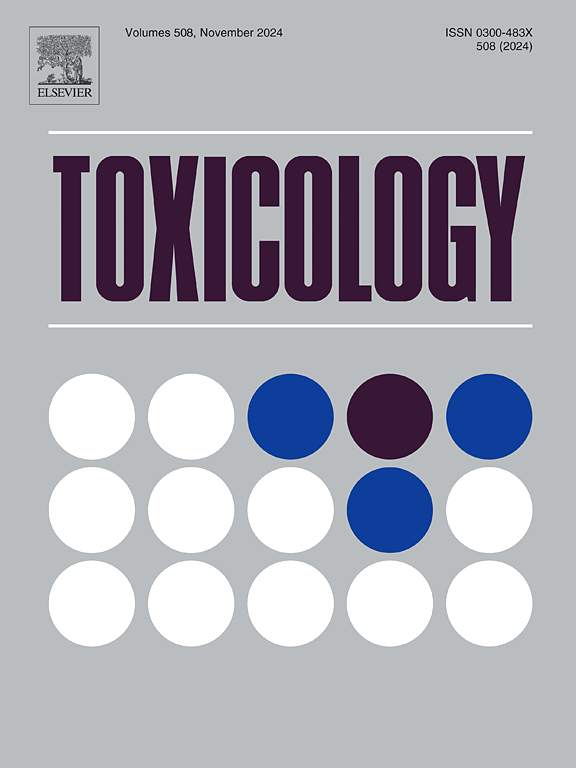Impact of per- and polyfluoroalkyl substances structure on oxidative stress and lipid metabolism disruption in HepG2 cells
IF 4.6
3区 医学
Q1 PHARMACOLOGY & PHARMACY
引用次数: 0
Abstract
Per- and polyfluoroalkyl substances (PFASs) are bioaccumulative pollutants that pose risks to ecosystems and human health, with oxidative stress and lipid metabolism disorder playing key roles in their hepatotoxicity. However, the toxicological differences between PFASs with varying chain lengths and functional groups remain unclear. This study exposed HepG2 cells to different concentrations (50, 100, 200, and 400 μM) of PFOA, PFOS, PFBA, and PFBS for 24 h to investigate their cytotoxicity and underlying mechanisms. Results indicated that all four PFASs reduced cell viability in a dose-dependent manner. Long-chain PFASs in particular, induced oxidative stress, as evidenced by elevated ROS and MDA levels. Metabolomics revealed significant alterations in lipid and amino acid metabolisms, with lipid metabolism being the most disrupted. Further analysis showed up-regulation of lipid metabolism-related genes and increased TG content, confirming these findings. Correlation analysis revealed that PFASs exacerbate oxidative stress and lipid accumulation through lipid metabolism disorders, resulting in reduced cell viability. Notably, long-chain PFASs (PFOA and PFOS) were more toxic than short-chain PFASs (PFBA and PFBS), and sulfonate-based PFASs (PFOS, PFBS) were more toxic than carboxylate-based ones (PFOA, PFBA) of similar chain length. This study provides insights into the differential toxicity of PFASs, offering a theoretical foundation for improved risk assessment and management of these compounds.
单氟烷基和多氟烷基物质结构对HepG2细胞氧化应激和脂质代谢破坏的影响。
全氟和多氟烷基物质(PFASs)是生物蓄积性污染物,对生态系统和人类健康构成风险,氧化应激和脂质代谢紊乱在其肝毒性中起关键作用。然而,不同链长和官能团的PFASs之间的毒理学差异尚不清楚。本研究将HepG2细胞暴露于不同浓度(50、100、200和400μM)的PFOA、PFOS、PFBA和PFBS中24小时,研究它们的细胞毒性及其潜在机制。结果表明,所有四种PFASs均以剂量依赖的方式降低细胞活力。特别是长链PFASs诱导氧化应激,ROS和MDA水平升高就是证据。代谢组学显示,脂质和氨基酸代谢发生了显著变化,其中脂质代谢受到的干扰最大。进一步的分析显示脂质代谢相关基因的上调和TG含量的增加,证实了这些发现。相关分析显示,PFASs通过脂质代谢紊乱加剧氧化应激和脂质积累,导致细胞活力降低。值得注意的是,长链PFASs (PFOA和PFOS)比短链PFASs (PFBA和PFBS)毒性更大,而相似链长的磺酸基PFASs (PFOS, PFBS)比羧酸基PFASs (PFOA, PFBA)毒性更大。本研究揭示了PFASs的不同毒性,为改进PFASs的风险评估和管理提供了理论基础。
本文章由计算机程序翻译,如有差异,请以英文原文为准。
求助全文
约1分钟内获得全文
求助全文
来源期刊

Toxicology
医学-毒理学
CiteScore
7.80
自引率
4.40%
发文量
222
审稿时长
23 days
期刊介绍:
Toxicology is an international, peer-reviewed journal that publishes only the highest quality original scientific research and critical reviews describing hypothesis-based investigations into mechanisms of toxicity associated with exposures to xenobiotic chemicals, particularly as it relates to human health. In this respect "mechanisms" is defined on both the macro (e.g. physiological, biological, kinetic, species, sex, etc.) and molecular (genomic, transcriptomic, metabolic, etc.) scale. Emphasis is placed on findings that identify novel hazards and that can be extrapolated to exposures and mechanisms that are relevant to estimating human risk. Toxicology also publishes brief communications, personal commentaries and opinion articles, as well as concise expert reviews on contemporary topics. All research and review articles published in Toxicology are subject to rigorous peer review. Authors are asked to contact the Editor-in-Chief prior to submitting review articles or commentaries for consideration for publication in Toxicology.
 求助内容:
求助内容: 应助结果提醒方式:
应助结果提醒方式:


